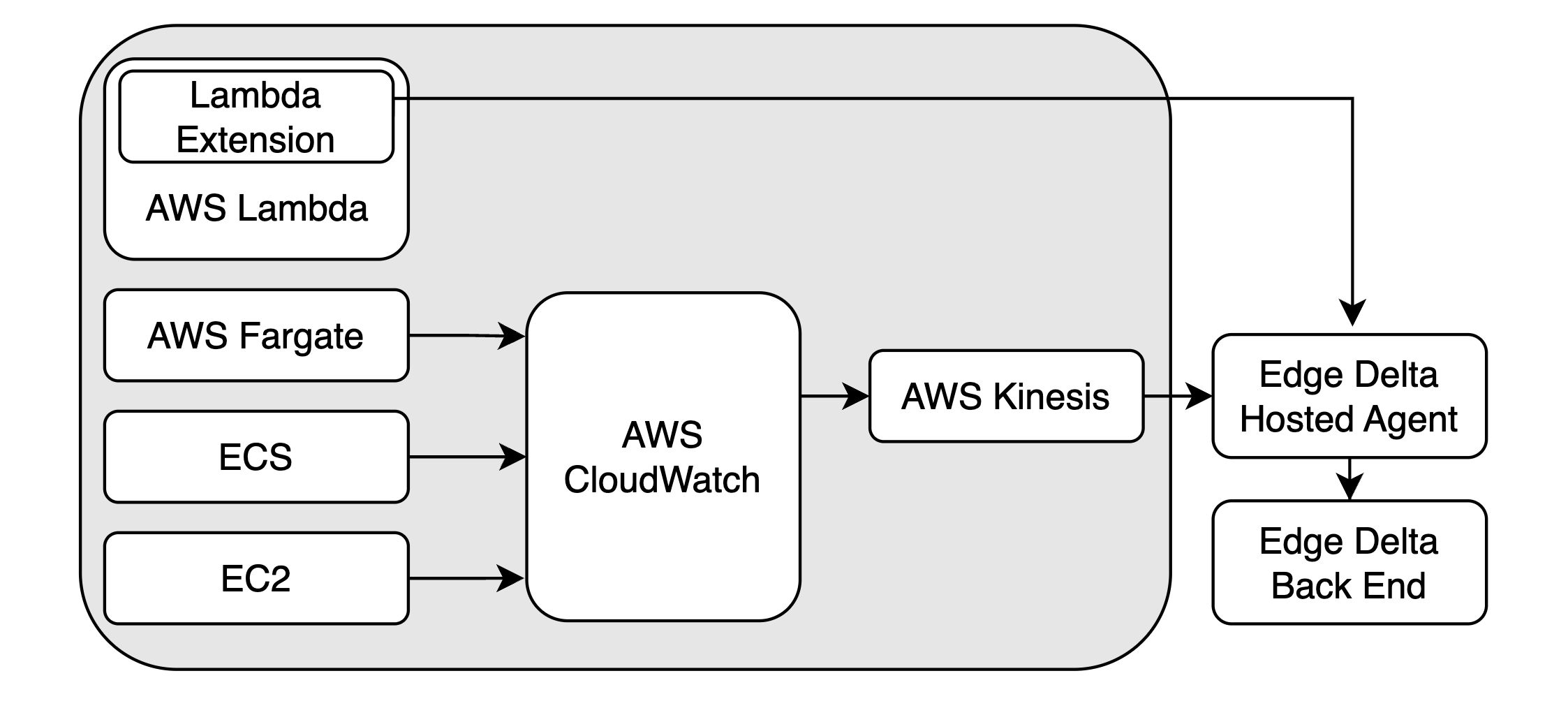Deploying the Edge Delta Lambda Extension
5 minute read
Overview

Edge Delta’s AWS Lambda Extension is deployed as a layer within your Lambda Function. See Serverless AWS Monitoring. It is published in the AWS Serverless Application Repository and there are layers for ARM64 or AMD64. The Lambda extension is run on AWS as a part of the lambda execution and lambda function logs are sent to the extension. The extension in turn sends logs to an Edge Delta Cloud pipeline.
To configure Lambda monitoring using the Lambda Extension:
- Create a Pipeline Configuration
- Create an Edge Delta Cloud pipeline.
- Deploy the Lambda extension.
- Specify the Cloud pipelines endpoint.
- Configure other environment variables as needed.
Create an Edge Delta Cloud Pipeline
Create a new Edge Delta Cloud pipeline.
- Click Pipelines.
- Click New Pipeline.
- Select Cloud
- Specify a name to identify the pipeline.
- Select Compute Units based on your estimated traffic volume. This is the maximum bandwidth the agent can handle before signalling an error. The number of compute units used per hour counts towards your plan usage.
- Click Deploy Cloud Pipeline.
Copy the HTTPS endpoint from the Cloud pipelines settings.
Modify the Pipeline
Modify the pipeline as follows:
- Connect the HTTP source to a Parse JSON Attributes node.
- Configure the Parse JSON Attributes node with the process_field
item.body. - Connect Parse JSON Attributes to an Extract JSON Field node.
- Configure Extract JSON Field to extract the whole
messagefield path to assign to the body, and setkeep_log_if_failed: true. - Connect Extract JSON Field to a Log Transform node.
- Configure the Log Transform node to delete
attributes.message(they are in body). Also deleteattributes.timestamp. - Add the following Pipeline settings:
settings:
multiline_max_byte_size: 11MB
max_incomplete_line_buffer_size: 10MB
These values should match the max of lambda/cloudwatch so there are no OOM issues.
Configuration Example
version: v3
settings:
tag: <configuration name>
log:
level: debug
archive_flush_interval: 5m0s
archive_max_byte_limit: 10MB
multiline_max_byte_size: 11MB
max_incomplete_line_buffer_size: 10MB
links:
- from: http_input_lambda_logs
to: parse_json_attributes
- from: ed_component_health
to: ed_health
- from: ed_node_health
to: ed_health
- from: parse_json_attributes
to: extract_json_field
- from: parse_json_attributes
path: failure
to: extract_json_field
- from: log_transform
to: ed_archive_output
- from: extract_json_field
to: log_transform
- from: extract_json_field
path: failure
to: log_transform
nodes:
- name: http_input_lambda_logs
type: http_input
port: 80
read_timeout: 1m0s
- name: ed_component_health
type: ed_component_health_input
- name: ed_agent_stats
type: ed_agent_stats_input
- name: ed_node_health
type: ed_node_health_input
- name: ed_pipeline_io_stats
type: ed_pipeline_io_stats_input
- name: ed_health
type: ed_health_output
- name: ed_archive_output
type: ed_archive_output
- name: parse_json_attributes
type: parse_json_attributes
process_field: item.body
- name: log_transform
type: log_transform
transformations:
- field_path: attributes.message
operation: delete
- field_path: attributes.timestamp
operation: delete
- name: extract_json_field
type: extract_json_field
field_path: message
keep_log_if_failed: true
Deploying the Lambda Extension
Get the ARN from the AWS Serverless Application Repository
- Open AWS Serverless Application Repository and click Available Applications.
- Search for EdgeDelta and select the extension (either ARM64 or AMD64).
- Confirm the layer template such as the application name and click Deploy.
The extension can be deployed multiple times if necessary by providing different names. Deploying with an existing application name upgrades the existing deployment if an upgrade is available.
- On AWS Lambda, expand Additional Resources and click Layers.
- Click the Layer you just created (
edgedelta-lambda-extension-arm64oredgedelta-lambda-extension-amd64) - Copy the ARN of the Lambda Layer.
Add the Layer to your Lambda Function
Add the layer to your Lambda Function using the CLI or using the Console.
CLI:
Replace <Function Name> and <ARN>
aws lambda update-function-configuration -function-name <Function Name> \
--layers “<ARN>"
Console
- Navigate to the Lambda Function you want to monitor.
- In the Layers section, click Add a Layer.
- Click Specify an ARN, paste the ARN you copied earlier and click Verify.
- Click Add.
Specify the Endpoint Environment Variable
To configure Environment Variables for the Lambda function:
- Open the Functions page of the Lambda console.
- Choose a function.
- Choose Configuration, then choose Environment variables.
- Under Environment variables, choose Edit.
- Choose Add environment variable.
- Enter a key and value.
Push Destination Variables
Configure the Pusher Mode as https and specify the Cloud pipeline endpoint URL you copied earlier.
PUSHER_MODE:Usehttpsfor hosted environments.ED_ENDPOINT:Specify the Edge Delta Cloud pipeline endpoint.
Configuration Variables
Configure any other environment variables you need:
ED_FORWARD_LAMBDA_TAGS: If set totrue, logs are enriched with lambda tags (in the field “lambda_tags”). Lambda function role needs to have thelambda:ListTagspermission.ED_LAMBDA_LOG_TYPES: The variable defines which types of logs you want to get from the Lambda Function. Options arefunction,platform,extension. Default isfunction,platform.ED_PUSH_TIMEOUT_SEC: Push timeout is the duration between sending batches of logs (in seconds). The default is 5.ED_RETRY_INTERVAL_MS: The initial interval to wait until the next retry (in milliseconds). It is increased exponentially until the Edge Delta process is shut down. The default is 100.ED_BUFFER_SIZE_MB: Maximum buffer size to keep logs (in MB). The default is 20. Some logs may be dropped if the buffer exceeds this limit.ED_FLUSH_AT_NEXT_INVOKE: If set totrue, logs are flushed at the start of the next invocation of the function. Normally, logs are flushed after the function execution finishes, which can add to the total running time. For lambda functions that are executed periodically,ED_FLUSH_AT_NEXT_INVOKEcan be turned on to reduce costs.ED_PRINT_EXTENSION_LOGS: If set totrue, the extension’s own logs are sent to CloudWatch.
Lambda can buffer logs and deliver them to the subscriber. You can configure this behavior in the subscription request by specifying the following optional fields:
ED_LAMBDA_MAX_ITEMS: The maximum number of events to buffer in memory. Default: 1000. Minimum: 1000. Maximum: 10000. This is also the size of the channel that the Edge Delta http server writes into and which inputs consume.ED_LAMBDA_MAX_BYTES: The maximum size (in bytes) of the logs to buffer in memory. Default: 262144. Minimum: 262144. Maximum: 1048576.ED_LAMBDA_TIMEOUT_MS: The maximum time (in milliseconds) to buffer a batch. Default: 1000. Minimum: 25. Maximum: 30000.